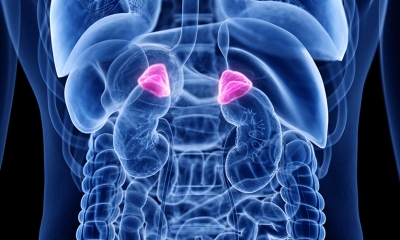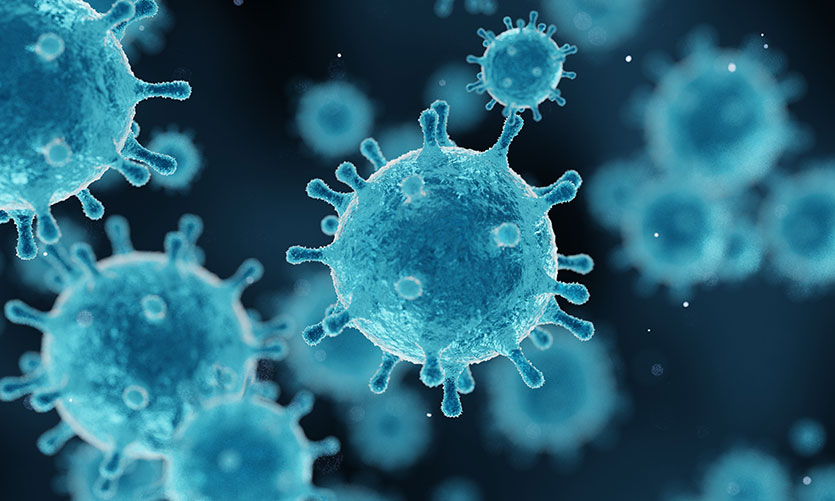Stress is part of the human experience. Since the evolution of early man, you’ve been hard-wired to encounter stressful situations. And though threats from predators may not be common in modern life, the fight-or-flight response has not been left behind. Evolutionary mechanisms for survival are useful tools for long-term health.
By harnessing the power of stress, you can empower your health. It’s true, a certain level of stress can be quite healthy. And given it is nearly impossible to escape stress in your daily life, this is good news. There are ways to utilize the benefits of short-term stress to create a calmer, more relaxed mindset. Purposeful stress—or good sources of stress—can activate cellular pathways that support greater resilience to other stresses.
Too Much Fight or Flight
Moments of crisis trigger complex physiological adaptations deeply engrained in your DNA. When you perceive your safety is in danger, these instincts prepare you to react. Short-term stress response spurs action through a flood of hormone responses. A sudden surge of cortisol and adrenaline produced in the adrenal glands prepares you to react quickly. But as the danger lessens, the parasympathetic nervous system presses the brakes on this excitatory response, helping to bring you back to baseline.
At optimal levels, stress hormones make you feel alive and activate better performance and focus. But when you are unable to return to a state of calm, or if your stress response is activated too often, the effects of chronic stress can take a physical and psychological toll. This negative impact can lead to a variety of health issues.
From Distress to Eustress
Your perception of negative circumstances ties directly to your behavior and the regulation of physiological responses. Adopting an optimistic outlook can change your mental and physical health for the good. By shifting your mindset in moments of stress, you can reframe how you handle these experiences.
Eustress is “good stress,” or normal-to-moderate psychological stress that’s actually beneficial. It helps activate genetically encoded pathways to help you deal with stress. The more you experience life with a positive attitude, new challenges will provide opportunities for growth, focused attention, and activation without expending all of your resources. In its best form, eustress can induce a state of flow—complete immersion and enjoyment in the process of an activity.
Some attributes of eustress include:
- lasts a short period of time
- energizes and motivates
- feels exciting
- increases focus and performance
Good sources of stress can include a job interview, riding a rollercoaster, the thrill of a scary movie, traveling, or even a first date. These experiences mobilize and stimulate you, making you anticipate what’s to come. Eustress is part of the joy of being human.
Find Your Edge with Short-Term Stress
Avoiding stress altogether isn’t the answer to better health. Many scientists believe building a resilience to environmental stress is the best way to fight back and live healthier.
Evolution has equipped you with an amazing system to handle daily stress. But your physiologic response—how hormones react to distress—is thrown off balance with too much stimulus. Short-term stress can amplify your life for the better, but raised levels of cortisol sustained over long periods can lead to poor health. Paradoxically, introducing voluntary bursts of controlled stress can help increase your stress tolerance.
A Life of Greater Resilience
The ability to cope with physiological stress depends on cellular-level adaptations mixed with your mental perception of difficult situations.
Of course, always consult with your physician before diving into a new routine. But if you’re healthy and excited to experiment with benefits from short-term, stress-inducing practices, give one of these five options a try. You may just open a new gateway for enhanced performance, better health, and a rewarding new adventure.
1. Eating to Adapt
Hormesis is a mild stress response that’s adaptive at a low dose and toxic in large amounts. A hormetic response can cause adaptations in cells and organisms to make them stronger and more robust. Foods you eat mimic this beneficial response to toxins and the transformative effect they can have on your health.
Toxic plant compounds are designed to affect the nervous system of insects and animals in the wild. But in humans, they have the possibility to make you stronger. Nutrient-dense plants have built-in defense mechanisms that can induce a healthy, manageable stress response. Phytonutrients from plants, despite being slightly stressful to the cells, precondition your body to respond to future stress by activating adaptive cellular stress-response pathways. Basically, a little poison can go a long way for improved health. See an example about liver detoxification here.
Common Compounds Found in Plants
- Saponins—quinoa
- Lectins—soy and potatoes
- Gluten—wheat, rye, and barley
- Anthocyanins—berries
- Resveratrol—grape skins and red wine
- EGCG—green tea
- Sulforaphane—broccoli and other cruciferous vegetables
- Catechins—cacao
People sensitive to these compounds shouldn’t consume them. If you have existing gut issues, talk with your health-care provider or nutritionist about the best strategy to incorporate healthy, mild stressors into your diet. If consuming a plant-based diet is problematic, cooking with herbs and spices is a great alternative.
2. Born to Move
A difficult workout can scratch your ancestral itch to move. Long gone are the days of scavenging for food or hunting for game to simply survive—activities your body was designed to do.
Today’s more sedentary lifestyle suppresses the all-day-long movement you instinctually crave. Regular exercise is essential for mental and physical health. It gives you more energy for life and serves as a buffer against the effects of stress and mental health issues by enhancing your brain’s endorphins—it’s “feel-good” neurotransmitters.
Movement and exercise of your skeletal muscle also creates oxidative stress in the body, triggering your defense response system. As it repairs, your body becomes stronger, creating a greater level of endurance. However, too much exercise can lead to chronic stress, so it’s important to listen to your body and exercise in the way that’s right for you.
3. Turn Up the Heat
Have you ever wondered why fitness clubs and health spas offer dry and steam saunas? It may seem counterintuitive to crank up the heat and endure the discomfort of a profuse sweat session.
Heat stress is a hot topic in many fitness and health circles today, but it’s been a regular practice in countries like Finland for thousands of years. The ancient practice of purification and healing by heat bathing has taken on modern significance. This lifestyle addition can induce feelings of relaxation and pleasure—whether used after a workout or as its own activity. Heat bathing is also associated with a calming effect and enhanced mood.
But heat stress is no joke. Regular, short-term exposure to extreme heat can have several positive health effects, including making you more resilient to biological stress.
Here are a few of the benefits of exercise and a regular, healthy sweat:
- Triggers an increased release of growth hormone
- Increases blood flow to skeletal muscles (muscle profusion) to help recovery and restore glucose, amino acids, fatty acids, and oxygen more efficiently
- Enhances endurance and supports cardiovascular health
- Increases red-blood-cell count
- Improves thermoregulatory control
- Enhances efficiency of oxygen transport to the muscles
- Supports healthy insulin sensitivity
With these compelling benefits, regular hyperthermic conditioning (intentionally heating yourself up) may just be the new habit you need for added endurance, improved health, and greater well-being.
4. A Cooler Way to Be Healthy
If you’ve ever stepped outside on a frigid winter’s day, you know how quickly your body reacts. Shivering begins almost immediately. Extreme cold is another hormetic stressor that can do wonders for your body.
Cryotherapy—exposing the body to extremely cold temperatures for a short amount of time—triggers cellular responses that can build physiological resilience. In the right doses, cold can affect the brain, immune system, and metabolism in amazing ways that may be worth the initial shock to your system.
Cold exposure has been found to have a positive effect on the sympathetic nervous system, helping to improve mood and anxiety. It’s also a powerful antidote for the negative effects of chronic stress.
The metabolic response to cold therapy exists for one purpose, to warm the body. As you shiver, your muscles contract involuntarily in an attempt to produce heat. Another process, non-shivering thermogenesis, causes norepinephrine—a hormone and neurotransmitter—to ignite a bodily response to create more mitochondria. As your body heats back up, it converts adipose tissue (fat) into a more metabolically active form. So, a cold dip could even be an exhilarating way to support weight maintenance.
Here are some ways to experiment with cold exposure:
- Schedule an appointment to test a cryotherapy chamber
- Construct a cold-water plunge tub in your backyard
- Crank the temperature way down for the last 60 seconds of your morning shower
- Add ice to your bathtub and take the plunge
- Dip into a cold river or lake
5. Fast for Metabolic Flexibility
Fasting—abstaining or limiting your consumption of food and drink—can seem contrary to healthy behavior and stressful for your body. After all, you need nutrients to feed and energize your cells. But taking periodic breaks from feeding may be the healthy strategy you need to boost resilience, energize and rejuvenate your body, and create favorable metabolic health changes.
As you fast, liver glycogen stores (carbohydrates held for later use) are depleted. This forces your body to flip a metabolic switch to shift your energy balance and mobilize fatty acids. In a fasted state, your body liberates fat stores and produces ketones as an alternative energy source to its preferred one—glucose.
Over time, metabolic stress from switching from a fed to a fasted state causes adaptations to improve metabolic and homeostasis function, enhance autophagy (the cells’ clean-up process), and support healthy weight management.
Common types of fasting include:
- Time-restricted feeding or intermittent fasting—limits food intake to certain designated times of day without reducing the number of calories you consume. The popular 16:8 fast limits food for 16 hours each day with an eight-hour feeding window.
- Alternate-day fasting—fasting every other day or consuming a small amount of food on “fasted” days.
- Prolonged fasting—a longer fast that usually exceeds 48 hours. This method should only be practiced with supervision from your healthcare provider.
Reconsider Your Healthy Routine with Stress Benefits in Mind
How humans experience stress has changed throughout history, but your evolutionary biology remains. You have the power to leverage stress-response to transform your health, enhance your performance, and change your mind about discomfort. Experiment with stress tolerance by adding purposeful stress into your health routine today. It’s a great way to help you experience the lasting benefits of short-term stress.
References
https://www.ncbi.nlm.nih.gov/pmc/articles/PMC5137920/
https://positivepsychology.com/what-is-eustress/
https://www.cell.com/trends/neurosciences/comments/S0166-2236(06)00200-1
https://pdfs.semanticscholar.org/72a8/583ccee1928028a128d40589ec60f253d6ec.pdf
https://www.ncbi.nlm.nih.gov/pmc/articles/PMC4142018/
https://pubmed.ncbi.nlm.nih.gov/30077204/
https://pubmed.ncbi.nlm.nih.gov/2759081/
https://pubmed.ncbi.nlm.nih.gov/18461718/
https://www.ncbi.nlm.nih.gov/pmc/articles/PMC2734249/
https://www.sciencedirect.com/topics/medicine-and-dentistry/nonshivering-thermogenesis
https://www.ncbi.nlm.nih.gov/pmc/articles/PMC5913738/
https://www.ncbi.nlm.nih.gov/pmc/articles/PMC5783752/
https://www.sciencedirect.com/science/article/pii/B9780128142530000127
Individual sports take mental toughness. They demand you set personal goals, manage stress, build self-confidence, and develop focus. Team sports build comradery and group empathy, but it takes a strong mindset to compete—at any level—alone on the court. These hurdles, once conquered, make the benefits of individual sports plentiful.
Consider swimming for example. You determine your goals in the water. Do you focus on your stroke or how many laps you want to swim? The water shuts out the world, leaving you with only your stroke and your thoughts. Left without distractions (earbuds or a monitor to watch), this is a good time to focus on yourself and explore why you’re swimming in the first place.
The challenge is to find the mental toughness to keep swimming—digging deep for inner motivation. It’s important to identify why you’re competing and how to improve your performance. Personal goals can range from setting a world record to improving upon last week’s swim.
Let’s take a deep dive into individual sports, how they develop mental toughness, and the ways error management benefits your performance.
Benefits of Individual Sports
Humans are inherently social. Like most mammals, social tendencies develop through interaction with others. Sports help develop social hierarchies and positive self-esteem in a group context. Playing with others is a way to channel aggression into constructive activities.
Individual sports address different aspects of personal development. Athletes who participate in traditional and non-traditional solo sports—like tennis, swimming, rock climbing, cycling, or bowling—don’t rely on teammates for motivation or performance assessments. They set and pursue their own goals. Bearing the responsibility for achievement, solo athletes must push themselves to establish a healthy, competitive mindset. This can be as simple as setting small, obtainable goals. Or in the grander scheme, it can mean doggedly pursuing more ambitious ones.
Most sports help develop fine and gross motor skills, agility, endurance, and hand-eye coordination. But many more unique benefits of individual sports are revealed to dedicated participants. That’s because solo sports also require an additional layer of mental development, along with physical fitness. Your success and failures are yours alone. As you embrace and overcome personal setbacks, strengthening your coping skills and resilience, you develop self-esteem and confidence.
Long hikes, easy swims, or bike rides are all individual sports great for relaxation and reducing stress. They can clear your mind, offer perspective, and allow time for self-reflection. Any form of exercise supports cardiovascular and pulmonary health, can help reduce stress, and build confidence for future exercise.
Mental Toughness and the Tools for Solo Sport Success
With non-competitive sports—like trail running, rock climbing, or weightlifting—individuals set goals and determine how to achieve them. Take a trail runner participating in a 50-mile race. The primary goal is to reach the finish line. But to accomplish it, the runner must meet a series of benchmarks ranging from strategy (pacing, hydration, stretching) to sessions (breaking the run into segments). Each runner must identify personal strengths and pitfalls and create a running plan to best meet his/her needs.
To prepare for the 50-mile race, the runner has to train physically and mentally. Taxing events like ultramarathons require a strong, healthy mindset during the training and competition phase. Mental toughness is how you respond to discomfort or manage an obstacle or challenge. The key to developing mental toughness is to strengthen your willingness and channel optimism.
Willingness is your commitment to endure physical challenges and power through discomfort. Multiple factors determine willingness, but the best indicator is having a specific goal you want to accomplish. If the trail runner can envision crossing the finish line at the end of the 50-mile race, they can develop the mental fortitude to push through discomfort.
Optimism is the power to visualize and believe in your ability to reach your goal. It bridges the gap between where you are and where you want to be. Optimism shapes your short- and long-term goals. It’s motivation to train each day, coupled with the unyielding belief you’ll finish the race.
Mental toughness is developed through a willingness to do the hard work, combined with the optimism to believe you can achieve your goals. Just like your hands develop callouses from hours of work, mental toughness strengthens your competitive advantage while training and competing.
Solo, but Not Alone
Even when you compete for yourself, you still benefit from the support of coaches and teammates. Coaches share their expertise to help you to train and develop to your furthest potential. They guide your workouts and provide encouragement. And teammates give you a competitive edge. They help you set goals, breed healthy competition, and challenge you to work harder.
To Err is to Grow
Identifying errors while participating in solo sports is key to improvement. And the benefits go beyond just your performance while engaging in the activity. Golf is a good example for tracking errors during play.
Golf can be a frustrating game. Even if you’ve never played before, golf presents a serious of pitfalls that can put you in a foul mood. From errant tee shots to missed putts, it’s easy to play but extraordinarily difficult to master. Join a foursome for a full 18 holes and you’re not just competing against the other players—you’re challenging yourself.
Imagine it’s a beautiful morning and you’re teeing up on the first hole. You grab your golf club of choice. After a couple of practice swings, you adjust your glove and prepare for your first drive. You smoothly raise your club behind you, engaging a series of muscles (external abdominal obliques, gluteus maximus, pectoralis major, latissimus dorsi, and forearms), and swing.
If everything goes right, you’ll connect with the ball and send it flying towards the hole. The average golfer (76 percent of all amateurs) will swing a club 100 times through 18 holes. That’s 100 opportunities to analyze your performance in real time, make adjustments, and experience good and horrible shots.
Essentially, golf is a game of error monitoring—the process of assessing performance, making adjustments, and recognizing pitfalls. Researchers have studied focused attention (FA) and open monitoring (OM) meditation in conjunction with error monitoring. FA is your mind absorbing contextualized information in the moment. OM is your mind in a state of calm where it processes collected information. Evidence points toward a higher level of error monitoring when golfers can balance their FA and OM.
Golfers who can identify errors in their game are more likely to predict conditional stressors and self-regulate stress. By absorbing the moment, a golfer may have a better outcome (i.e. a more successful shot) than those who are indifferent to the situation. Specifically, when a golfer focuses on the shot ahead instead of the whole round of golf, they perform better and achieve a stronger level of overall satisfaction—even if the outcome is diminished performance.
Error monitoring is not only identified in golf. Numerous solo sports have real-time error monitoring. Mountain bikers make split-second decisions while navigating rocks, tree roots, and other obstacles. Kayakers experience the same immediate error monitoring maneuvering through rapids. Successful solo athletes have developed this common skillset to optimize their performance.
And the benefits are not limited to sports—developing error monitoring transcends to work and home life. Tracking your performance in real time can assist with decision making, organizational skills, and self-calming techniques.
Finding the Balance
Participating in solo sports is an opportunity to focus on yourself and your performance. Regular training can improve cardiovascular health, motor skills, and general health. In addition, the benefits of individual sports extend to improving your mental acuity for additional success.
From fly fishing to everyday life, balance shapes success. As you build up and come to rely on your own motivation, mental toughness, and error management, you’ll carry the personal skills to accomplish your goals. Individual sports can help your mental strength outside of the activity with improved mental focus which can assist in other aspects of your life.
References
http://www.kshsaa.org/Public/PDF/AcademicPerformance.pdf
https://www.ncbi.nlm.nih.gov/pmc/articles/PMC2527715/
https://www.psychologytoday.com/us/blog/in-flux/201410/the-importance-being-alone
https://www.runnersworld.com/runners-stories/a20783068/four-ways-to-build-mental-toughness/
https://www.huffpost.com/entry/the-power-of-a-present-mi_b_5615239
https://www.sportsrec.com/4592745/muscles-used-in-the-golf-swing
https://www.mdpi.com/2076-3425/9/9/226/htm
https://us.humankinetics.com/blogs/articles/developing-good-teammates
https://pubmed.ncbi.nlm.nih.gov/18727786/
https://www.psychologytoday.com/us/blog/the-power-prime/201009/sports-focus-control
Hormones fuel so much of how you experience life. Happiness has a hormone. Love has one. Stress has several.
Their power comes from the ability for hormones to influence so many aspects of your health. These complex molecules transfer messages all around your body. They can help you feel serene or stressed. They up the tempo on your heartbeat or ramp down your systems so you’re ready for bed.
Even though they’re some of the most important messengers in your body, how much do you know about hormones? Are you an expert on which hormones are associated with specific life situations? Do you know where cortisol or insulin or melatonin come from in your body?
Show off your knowledge by playing the hormone match game. Answer the questions below by selecting the hormone or hormones that correspond with the action or place of origin.
Play the Hormone Match Game
Your Hormone Cheat Sheet
Need to know more about hormones? Learn all the information you need to know to come back and ace the quiz next time—and help you understand how these important messengers impact your health.
- Insulin: This key hormone in metabolism is produced in the pancreas and allows cells all over your body to take in the energy they need—especially via glucose, but also through fat and protein breakdown.
- Cortisol: Your main steroid stress hormone’s production is handled by the adrenal glands, but it’s triggered by your brain in response to stressors. It impacts many areas of the body—from blood pressure, memory, and metabolism to balancing salt and water.
- Adrenaline: That jolt created by adventures—like rollercoasters or skydiving—is thanks to the flight-or-flight hormone made in your adrenal glands. It preps your body’s systems—cardiovascular and muscular, especially—to flee or defend yourself from a stressor.
- Estrogen: This key female sex hormone is mainly produced in the ovaries and controls menstrual cycles and promotes the growth of reproductive anatomy during puberty. It also plays a role in mood, bones, cardiovascular function, and the skin. Found in limited amounts in men, as well.
- Testosterone: A key male sex hormone mainly produced in the testes. It helps with the development of male-specific physical features during puberty, and spurs sperm production. Testosterone is also found in women in limited amounts.
- Glucagon: The name tells you a lot about this pancreatic hormone that helps support healthy blood sugar levels.
- Norepinephrine: Since it’s made in the adrenal gland, this hormone’s connection to stress is pretty clear. As a response to exercise or a stressor, norepinephrine plays a role in heart rate and energy usage. It also acts as a neurotransmitter and impact mood and emotions.
- Melatonin: Your sleep hormone originates primarily from your brain’s pineal gland. It helps regulate normal sleep and wake cycles by helping your body prepare for slumber.
- Oxytocin: Love’s favorite hormone helps build bond and deepen connections. It starts in the hypothalamus, but the pituitary gland is responsible for secretion of oxytocin. The love hormone also plays roles in reproductive function, lactation, and social behaviors.
- Serotonin: You may know it for ties to mood and happiness, but serotonin plays roles throughout your body—in digestion, sleep, bone health, and wound healing. It’s produced by nerve cells all over your body.
References
Your body may be about 60 percent water, but you’re 100-percent cells. They make up your whole body, but still act—and react—individually. That’s very apparent when it comes to stress. Individual cellular stress responses are very different than the way your whole body responds to a stressor.
You’re likely all too familiar with those bodily responses to psychological stress. Many people have an intimate knowledge of the tension, increased heart rate, and possible gastric gymnastics. But you might not be full acquainted with how your cells respond to stress—or even how cellular stress differs from everyday stress.
It’s time to better understand what your cells go through and how they react. And also come to grips with the role your decisions have and how you can use selective cellular stress to help support your overall health.
What Stresses Cells Out
One way to look at stress of any kind, is as something that upsets a delicate balance. In daily life, that means frustrating delays impacting your deadline or unexpected expenses upending the budget.
Your cells crave balance so much that maintaining homeostasis is their operating principle. A cellular stress response is triggered whenever cellular balance is thrown a bit out of whack or when the serenity of homeostasis is even threatened.
That’s why many cellular stressors are best described as environmental changes in or directly around the cell. And your cells are hard-wired to react to their environments. Some changes are good and necessary. It’s actually an essential part of how your body runs—from nutrient distribution to energy production and more. But some environmental changes are more worrisome to the cell than others.
Take the following list of most common cellular stressors, for instance:
- Temperature Increase: There’s a good reason your body sweats. It’s kicking on the evaporative cooler (your skin) to maintain a good operating temperature. Your cells thrive in a certain temperature range. Throw off that thermal balance with a little extra heat, and your cells start the stress-response processes you’ll read about momentarily.
- Exposure to Toxins: Cells are tiny pouches containing many chemical reactions. Any interruption to this chemistry—especially by toxins, but even by nutrients that may act like a toxin—throws a wrench into normal operation. That’s enough to trip the stress-response wire.
- Lack of Energy Resources: Your cells contain the machinery to manufacture energy from your diet. But if you fast or limit calories, cellular environmental conditions change enough to trigger a stress-response process called autophagy—more on that later.
- Oxidative Stress Accumulation: A certain amount of reactive oxygen species (ROS) are common in cells. They’re a byproduct of energy production in the cellular mitochondria. Too many of these particles floating around tips the balance and creates oxidative stress—and accompanying reactions—in your cells.
You are also a source of stress for your cells. Your lifestyle decisions determine a lot about the cellular environment. So, when you make a thousand different decisions—exposing yourself to toxins, deciding to adopt intermittent fasting, failing to stay hydrated, or consuming a high-fat diet—your cells may pay a stressful price.
And your daily and chronic stresses can impact your cells. That makes stress management and healthy habits key to keeping your cells calm and happy.
Equal and Opposite Reaction—Your Four Cellular Stress Responses
Most of the negatives of stress—at a cellular or macro level—come from the way your body responds. Consistently high levels of cortisol are correlated with chronic stress and account for some of the ways stress hampers your health. Your cellular stress responses can be just as harmful.
Let’s start with the worst news first: sometimes your cells’ response to stress is just to say “enough is enough” and die off in a process called apoptosis. This, obviously, is not always ideal. But it’s could actually be worse—after all, it’s a natural process and part of human development.
Apoptosis could even be described as a type of sacrifice. The process acts to hopefully avoid the more devastating cell death eventually caused by a stressful stimulus. That’s because it has less of an impact on surrounding cells. But stressing your cells to the point where they opt for apoptosis or succumb to the stress is still the worst-case-cellular-stress scenario.
Cell death may be necessary to destroy damaged cells. The good news, though, is there are other signals telling cells they should continue living.
One of the better signaling outcomes involves cell repair mechanisms. Stress can damage proteins by making them unfold—and DNA can even be harmed. The answer to impaired proteins? Signaling cells to release a different set of proteins. These helpers repair or contain the damage to help return the cell to normal.
Autophagy was mentioned above, specifically in connection to fasting. This important cellular stress response is used more for cleaning and recycling than repair. When proteins degrade, autophagy further disassembles them into component amino acids the cell can use again. Even though it translates literally to “self-eating,” autophagy is a natural and important part of maintaining optimal health. (Want to dive deeper into autophagy? Read more about cellular renewal processes.)
Adaptation is the final approach your cells typically takes to stress. Adapting, which start in the DNA, involves complex processes with several cellular pathways. It’s a lot to digest, but the end result is pretty simple and very positive—resistance and resilience.
Using Cellular Stress to Your Advantage
Your cells’ ability to adapt to or spark cellular-cleaning processes in response to low-level stressors creates an exciting opportunity. And it’s one you can capitalize on to support your cellular and overall health.
The most common way to take advantage of cellular stress resides in the realm of nutrition.
Intermittent fasting evangelists advocate longer periods of zero-calorie consumption partly due to ties with autophagy. Here’s how the logic for this conclusion flows: Research supports the connection between the cellular recycling process and caloric restriction or abstention. The benefits of autophagy for supporting and maintaining optimal cellular health are also well established. And, since cellular health plays a big role in overall wellness, that intentional stress becomes a boon instead of a burden.
Nutritional science has also uncovered the role some nutrients can play in strengthening your cells through stress. These molecules—mostly falling under the phytonutrient label—originate from plants, where they have protective effects. These same abilities help the phytonutrients act as a mild toxin, which activates beneficial cellular stress responses.
So, don’t just fear stress—use it to your advantage. Think of all this as exercise for your cells. Overcoming a small, controlled amount of stress strengthens and promotes resilience. And that’s another important way to help support your health.
References
https://www.livescience.com/20355-5-ways-cells-deal-stress.html
https://www.ncbi.nlm.nih.gov/pmc/articles/PMC4362434/
https://www.hindawi.com/journals/ijcb/2010/214074/
https://www.sciencedaily.com/releases/2016/02/160208083550.htm
https://pubmed.ncbi.nlm.nih.gov/30172870/
Music is powerful.
Think back on the epic-ness of experiencing your favorite bands in concert, or the nostalgia of listening to an album you revered in high school. Or stifling the urge to dance to your favorite song while shopping. Nothing’s quite as validating as your tunes echoing through the food court or down the baked goods aisle. Music speaks to the soul. That’s part of how music is calming and can help you relax, pump you up during a run, or even help you focus at work or school.
Thanks to science, this emotional range isn’t just anecdotal. Listening to music comes with tangible benefits, including a direct correlation between music and stress relief. Understanding the chemical reactions in your brain relating to sound is key to unlocking the calming magic of music. Even if you already know how awesomely powerful music can be, now you can explain it with sound science.
How Sound Harmonizes with Your Mood
Sound waves affect hearing, one of your five primary senses (scientifically called audition). Hearing is intrinsically linked to many of your body’s physiological reactions. Your ear drums pick up sound from a variety of sources, like birds chirping, a friend’s voice through a cell phone, the chime of an oven timer, or your amped-up workout playlist. The brain converts these sound waves into electrochemical nerve signals—and this is where sound really strikes a chord.
Sharp, loud noises trigger your brain to release cortisol, increasing your heart rate and priming the fight-or-flight response. The sound of a familiar or foreign voice will set off a different chemical cascade, and your brain and body respond accordingly. And though it used to be vital to survival, such a well-developed auditory system is now far more useful for communication. With the concerns of humanity shifting from wildlife to the workweek, your ears are tuned less to leopards and more to Def Leppard.
So, how does music reduce stress? Scientific evidence shows music affects your body like any other sound. Rhythms, beats, and audio samples often imitate nature, and the power of voice carries through both analog and digital means. Your ears signal your brain to produce dopamine, whether it’s Johnny Cash crooning or a favorite uncle cracking another bad joke.
Depending on the track, songs can impact:
- dopamine, DHEA, cortisol, and other hormone levels
- heart rate, respiratory rate, and blood pressure
- the psychobiological stress system
- perceived stress levels and mood
- post-task mental and physical revitalization
- alertness and energy levels
With such an array of physical and chemical effects, it’s no wonder there’s a strong correlation between music and stress relief. Many of these same chemicals are linked to emotion, making music another sure way to master your mood.
Beat Stress with BPM—Beats Per Minute
Music can reduce stress and positively affect your body in a variety of ways. You may find yourself asking, “Is this true of all music?” “Does the scale make a difference?” And what if you can’t stand classical compositions—will they still help you focus?
As it turns out, taste has a lot to do with it. The same piece of music affects listeners differently based on listening tendencies, what they grew up rocking, and various attachments to the song. Perception is a powerful indicator for how sound will affect an individual. This is quite similar to how your experiences shape the unique wiring of your brain. So, if you don’t like folk music, there’s no shame in staying away from twangy ensembles.
Before you jump into how beats per minute (BPM) impact stress, there are other predictors to determine how a song may affect you—whether it’s funky or flat, good for studying, or a party anthem. Major tones are often associated with happy, predictable, poppy songs, while minor tones seem to be sad, more complex, and dissonant. This carries over to speech and vocals, too. As a fun experiment, search for your favorite upbeat song in minor on YouTube and hear the mood flip. Take on Me by A-Ha sounds like an unreleased act from Phantom of the Opera.
A song’s tempo has a lot to do with its potential stress-busting effects. Every piece of music is measured by beats per minute (BPM). Songs range from a very slow 35–45 BPM up to a heart-fluttering 200 BPM. For reference, the average popular song pulses around 116 BPM, and 120 is often considered the sweet spot for pop. You can find any song’s BPM through a quick online search, or through a free service like SongBPM.com.
Studies show listening to music you can’t stand is a recipe for disaster at any tempo. But listen to an artist or album you love, and you’ll experience the calming powers of sound. The slower a song, the more likely you are to experience deeper breathing, lower blood pressure, and a lower heart rate. Faster music has the opposite effect—pumping up your vitals and propelling you to move.
Speaking of music you love, set aside time this week to ignore your social feeds, close your eyes, and enjoy a deep listen of a favorite album. Purposeful listening lets you experience every track as the artist intended, and it’s a great way to add a meditative moment to your day.
Measurements for Every Occasion—Music to Relieve Stress or Pump You Up
The inextricable link between music and stress relief lets you use sound to create a productive rhythm for each part of your day. Whether preparing for a test, exercise circuit, or bedtime—all it takes is the right range of BPMs.
- Rise and shine. Many people have their favorite dance-worthy song set as their alarm—and they’re doing morning right. Aim for a bright and poppy tune, around the 120 BPM mark, to wake up on the right side of the bed every day.
- Sweat it out. Nothing starts the blood pumping like a custom workout playlist. Exercise routines vary in intensity and time, so curate a range of heavier, upbeat tracks that range between 120-160 BPM. More motion = more beats.
- Eco-commute. The average person walks at a convenient 120 steps per minute. Jamming music in this range will help you keep pace through hills and road bumps. Pedaling a bicycle calls for the same pace—unless you’re fighting the wind, which means upwards of 160–180 BPM.
- In the zone. Like musical tastes, finding the creative flow state varies from person to person. Instrumental music around 50–80 BPM is an ideal range for studying, working, or reading. Your brain falls into a productive rhythm in this range.
- Sauté success. Once again, the trusty 120 BPM is recommended for a perfectly paced dining experience—any faster and you’ll be rushing to chow down. The true key to pairing food with music is context. Find flavorful tracks to fit the mood of the meal.
- Breathe deep. Like the creative flow, mellow tunes around 50–80 BPMs can induce a meditative state. Find instrumental music that relaxes you. Clear your mind and focus on measured breathing to slow down your thoughts.
- Sweet dreams. Music around 60 BPM can induce alpha brainwaves—ideal for relaxation and sleep after listening for 45 minutes or so. Decompress with the right soundtracks to enjoy stress-free slumber.
More Stress-Relieving Solutions
Find harmony in stressful moments with both quick fixes and long-term solutions:
- Mindfulness through meditation provides fast relief.
- Stepping outside for even 20 minutes can trigger many beneficial physiological reactions.
- Expressing gratitude increases feelings of happiness to put problems in perspective.
- Exercise is one of the best ways to work out anxiety and temporarily lower blood pressure post-workout. Always bring your music library along for the circuit.
Healthy habits also play a significant role in how you feel, think, and perform:
- Start each day with a healthy breakfast for a positively productive morning.
- Consistent, quality sleep is deeply tied to your emotional state. Good sleep hygiene is crucial to minimize daily stress.
- Learning to play an instrument is challenging, but the brain benefits are incredible.
- Immersing yourself in any hobby helps to center the mind.
Some amount of stress can be productive, such as the nudge of anxiety prompting you to study for a concerto or attend band practice. But if you find yourself chronically stressed, consult with your trusted health-care provider and mental-health advocate.
More Than a Feeling
Life has its highs and lows, but no matter what happens, you can always turn to a favorite tune to brighten up the moment, finding stress relief through music. Spend time creating your own “stress less” playlist so you always have tracks to turn to for some extra feel-goods. You can even make collaborative playlists with friends, a true win-win—discovering awesome new music and maintaining social connections, which are key indicators of lifelong health.
So, next time you’re debating if those concert tickets are really worth the price, whether you can make the time to go, or if it’s worth the drive—whatever the excuse—now, you can justify it with science. Just make sure you pop in earplugs before you rock on.
References
https://www.ijpp.com/IJPP%20archives/2017_61_4/445-448.pdf
https://www.pnas.org/content/116/9/3793
https://www.ncbi.nlm.nih.gov/pmc/articles/PMC3734071/
https://www.ncbi.nlm.nih.gov/pmc/articles/PMC3339577/
https://www.sciencedirect.com/science/article/abs/pii/S0020748913000965
https://www.tandfonline.com/doi/abs/10.1080/00140130600899104
http://researchonline.rcm.ac.uk/31/1/PH16%20v01.pdf
https://www.sciencedaily.com/releases/2017/03/170330132354.htm
https://www.unr.edu/counseling/virtual-relaxation-room/releasing-stress-through-the-power-of-music
https://www.jneurosci.org/content/37/24/5948
Your brain is hard-wired to protect you from harm—especially in the face of real (or even imagined) stress. The initial response to a stressful situation provides a burst of energy to help you respond to the perceived threat. That’s partially why occasional stress and anxiety can help provide the motivation you need to tackle a big work project, study for a test, or start a new job.
Stress is caused by external stimuli (also called a trigger), while anxiety is part of the internal response to stress. And even though stress is an unavoidable part of life, humans aren’t well-equipped to endure prolonged periods of stress and anxiety. So, unmanaged stress or chronic anxiety can wreak havoc on emotions, memory, and overall health.
COVID-19—the disease caused by the novel coronavirus—and the information overload it has caused, has increased worldwide levels of stress and anxiety. The human brain is complex and provides the unique ability to imagine threats to your health, including how this virus could cause harm. The majority of people with COVID-19 recover and only experience mild-to-moderate symptoms—body aches, fever, and cough. But the uncertainty of how it will impact physical, financial, and social health (and that of loved ones) has led to unprecedented levels of stress and anxiety.
How Stress and Anxiety Work—A Refresher
Human ancestors needed the fight-or-flight response to survive their harsh world. When fearful or stressed, a rush of adrenalin prepared them to flee dangerous situations or fight to defend their ground and survive. In a modern society it’s rarely needed for actual survival.
Stress causes a chain reaction that begins in your protective brain. When you experience an event perceived as fearful, the amygdala—an almond-shaped mass located in each brain hemisphere—kicks into gear. This complex mass of cells helps regulate survival instincts (fight-or-flight responses), emotions, hormonal secretions, and memory.
Research suggests that the amygdala is also involved in the anxiety process. People with anxiety disorders are thought to have over-reactive amygdalae. The amygdalae are part of a larger network within the central nervous system that regulates the physiological effects of stress and anxiety.
The body’s stress response system is designed to engage when needed and disengage when the threat has passed. Feeling anxious and stressed is part of this temporary process to help keep us alert for signs of danger. But persistent stress and anxiety can become problematic and interfere with physical and mental health.
An ongoing global pandemic creates conditions for persistent stress. So, it’s important to understand how the COVID-19 crisis could potentially affect your mental and physical health and find ways to manage the stress and anxiety you’re feeling.
How Information Overload Contributes to Stress and Anxiety
The world has evolved from just using the internet for work or school. Now it’s a conduit for entertainment, a way to meet and connect with people, and an outlet for world-wide news. And it’s all at your fingertips, 24 hours a day.
For many, a good morning routine starts with reading a newspaper, scrolling through social media posts and news feeds, watching the news, or listening to the radio. But is this a healthy way to start the day?
A 2014 survey conducted by National Public Radio (NPR), the Robert Wood Johnson Foundation, and the Harvard School of Public Health found that 40 percent of those surveyed reported feeling stressed during the previous month. These respondents also mentioned reading or hearing news reports as a contributing factor.
Most people haven’t lived through a global pandemic as deadly as COVID-19. Almost everyone’s way of life has abruptly changed due to a tiny little virus—not visible to the human eye—that has caused a global health and financial crisis. And it’s made many fearful of the unknown.
The modern, 24-hour news cycle provides a continuous flow of rapidly evolving information from around the globe. News about COVID-19 is everywhere and not limited to credible information sources. Blogs, websites, and social media accounts are filled with opinions and information that may or may not be accurate.
This relentless flood of information makes it difficult to distinguish between what’s reliable and useful, sensationalized, full of half-truths, or blatantly false. When you factor in the mandated social distancing that keeps loved ones apart, financial struggles, and the fear of the unknown, it’s no wonder that people feel overwhelmed and powerless. And this contributes to more stress, anxiety, fatigue, and feelings of helplessness.
It’s normal to feel frightened and anxious in stressful situations that you can’t control. And the good news is there are aspects of life you can control and strategies you that can try to help you manage and alleviate stress and anxiety.
Stress is a cycle with many phases and symptoms. You can change the way you manage stress and that can help improve the way you feel. It’s important to pay attention to your physical and mental health, and recognize the signs and symptoms of stress in your loved ones. That way you’ll know when to seek help.
Identifying Signs of Stress
Everyone experiences occasional stress, but it’s the response to stress and anxiety that makes the difference. The symptoms of persistent, unmanaged psychological and physical stress are many. Here are a few noteworthy examples:
- An increase or decrease in activity or typical energy levels
- Difficulty sleeping or relaxing
- Rapid heartbeat
- Frequent headaches
- Gastrointestinal upset
- Changes in appetite
- Heightened alertness
- Feeling more irritable or angry
- Excessive worrying
- Feeling depressed or unusually sad
- Feeling tired
- Inability to have fun or experience pleasure
- Preferring to be alone
- Feeling anxious, fearful, or confused
- Difficulty making decisions and thinking clearly
- An increase or decrease in the use of alcohol, tobacco, or in the misuse of legal and illegal drugs
Long-term activation of your body’s stress-response system can increase the risk of developing serious health problems. That’s why it’s important to recognize the signs and symptoms of stress and take appropriate action to manage them before they spiral out of control.
Tips for Managing Information-Related Stress During COVID-19
You may not be able to control the world to remove stress, but it’s possible to change the way you respond to stress. And that can make all the difference in how you feel. Reducing stress often provides immediate relief and can provide long-term benefits for your health. Learning to cope with stressful situations now can even help make future ones easier to manage.
Like you read about above, information is important, but also can become overwhelming. Find a balance between staying informed about the COVID-19 outbreak while maintaining sanity and lower stress levels. Spending too much time watching and worrying can lead to increased levels of stress and anxiety.
Start by setting limits on how much time you spend online or watching the news. Also, identifying the “why” behind unhealthy media habits is the first step toward breaking the habit.
Don’t just limit your time stewing in the news of the day. Limit the sources of information to quality, credible outlets. Information can change rapidly as more is discovered about this virus. That’s why it’s vital to find accurate and trustworthy sources. Knowing the facts can help you protect you and your loved ones, and bring a sense of calm to help you mentally manage through trying times.
Good sources of for information about outbreaks from infectious diseases include:
- Your physician
- State or local health departments
- Government health agencies
- International health organizations (like the World Health Organization) are good sources
Take a Calming Deep Breath and Learn Strategies to Cope
Instead of disappearing down the rabbit hole of information overload, there are activities you can do and habits you can adopt to help fight the extra stress of the pandemic.
- Socialize, share, and safely see others: Most people are social. That’s why it’s been so difficult to quarantine or social distance from friends and family. Social support is a critical component of healthy relationships and resilient psychological health. Your network of family and friends play a key role in your daily life and you play a role in theirs. This emotional support system is there for you in times of stress to bolster you and help push through hard times.
Talk with family, friends, or loved ones who may be experiencing similar stress and anxiety. A study in the journal Behaviour Research and Therapy found that individuals who were able to successfully write or verbally express their stress-related feelings experienced significant improvements in their own physical health.
Connecting with others to share reliable information, express feelings, and voice concerns may help you develop healthy strategies to better cope during stressful times. If you can’t safely be with family and friends physically, find ways to connect virtually. FaceTime, ZOOM, Google Hangouts, and many other video chatting options are available for virtual visits. Or do it the old-fashioned way, through a phone call, a text, email, or letter—whatever works best. You could also consider joining an online coronavirus support group.
- Designate periods of time each day to unplug from devices: Turn off the TV, smart phones, and other connected devices. The information will still be there when you’re ready to reconnect.
- Schedule regular times to relax your body and mind: You have many options: Meditate, do yoga, breathe deeply, practice mindfulness, take a bath, read a book, enjoy a hobby, listen to soothing music, gently stretch, or go for a walk or run. Exercise is especially helpful to relieve built-up stress and reduce the accompanying muscle tension.
- Dose up on nature: Research shows that spending time outdoors relieves stress and lowers stress hormones. When you’re outside enjoying nature, blood pressure and heart rate decrease, mood improves, feelings of anxiety and stress diminish, and mental clarity improves. During the COVID-19 pandemic, enjoying the outdoors also provides a good way to socially distance.
- Focus on healthy choices: Making healthier choices to care for your body will have a positive impact on your overall health and well-being. Skip the fast food line and strive to prepare and eat regular, healthy meals with plenty of fruits, veggies, whole grains, and lean protein sources. And don’t forget to stay hydrated. Ensure you’re tucking in for the recommended amount of sleep (7-9 hours) each night. Also, wash your hands regularly.
If you just can’t seem to control the stress and anxiety you’re feeling, and it’s impacting your health and daily life, please seek help from a professional healthcare provider. A health professional can help bring clarity to what you may be feeling, and provide you additional coping tools.
Take Care of Yourself
Learning new ways to decompress and find stress-free moments in everyday life is important for long-term health anytime. But this is especially important during a global pandemic.
It’s understandable to feel anxious and worried about what’s happening in the world, and what could happen to many aspects of life. The most important thing to remember is to listen to what your body is telling you—know what you’re feeling inside—and give yourself what you need, when you need it. Strive to remain hopeful, celebrate successes even if they are small ones, express gratitude and love, and don’t be afraid to seek professional help if you need it.
References
https://www.cdc.gov/coronavirus/2019-nCoV/index.html
https://www.mentalfloss.com/article/92306/7-tips-staying-informed-without-experiencing-media-burnout
https://www.stress.org/how-the-brain-balances-feelings-of-stress-and-calm
https://www.nimh.nih.gov/health/publications/stress/index.shtml
https://www.stress.org/stress-effects
https://www.tuw.edu/health/how-stress-affects-the-brain/
https://www.mayoclinic.org/healthy-lifestyle/stress-management/in-depth/stress/art-20046037
https://www.health.harvard.edu/staying-healthy/understanding-the-stress-response
https://www.sciencedirect.com/science/article/abs/pii/0005796793901054
https://wexnermedical.osu.edu/blog/how-to-cope-with-coronavirus-stress
https://www.cdc.gov/coronavirus/2019-ncov/daily-life-coping/managing-stress-anxiety.html
https://health.clevelandclinic.org/7-strange-things-stress-can-body/
https://www.psychologytoday.com/us/blog/why-we-worry/201206/the-psychological-effects-tv-news
https://www.worldatlas.com/articles/10-ways-to-reduce-stress-during-a-pandemic.html
https://www.nytimes.com/2020/04/01/well/mind/coronavirus-stress-management-anxiety-psychology.html
Stress is a fact of life and so is cortisol—your constant companion during stressful situations. Cortisol is there for brief stressors, like when you wake up late and have to rush to work. And cortisol is with you when stress is more long term, like when you are dealing with a chronic illness.
There’s a lot to know about your body’s primary stress hormone. That’s because it does a lot more than make you feel overwhelmed. Check out this list of cortisol facts and see all that this hormone can do.
- Cortisol is a Hormone that Travels in the Blood
Cortisol is a steroid hormone secreted into the blood as a response to stress. Anything stressful can make cortisol levels to rise. It can be commonplace, like stress at work or at home. Or it can be stress from physical treats like a car accident, a hard fall, or any encounter with danger. Elevated cortisol is part of your body’s natural reaction to these stressful situations.
It’s the main chemical messenger that can relay instructions or information from one part of the body to the other during times of stress. That’s probably why cortisol is often referred to as the “stress hormone.”
Usually cortisol levels peak when stress is high and returns to normal when stress subsides. Spikes in cortisol can help your body perform under pressure. But when cortisol concentration stays elevated for too long, some body functions can be negatively impacted.
- Adrenal Glands Manufacture Cortisol
Sitting on top of each kidney are the triangle-shaped adrenal glands. Since kidneys filter blood, it’s an ideal place for producing this hormone. That way, cortisol has an easy path from the adrenal glands into the bloodstream.
Even though cortisol is made in the adrenal glands, they can’t release it into the bloodstream on their own. The adrenal glands wait for special instructions from the brain before they secrete cortisol into the body.
- The Pituitary Gland Controls Cortisol Release
The adrenal glands’ commands come from a small, pea-sized region of the brain called the pituitary gland. From its location in the center of the brain—behind the eyes—it controls the release of many hormones in addition to cortisol.
The pituitary gland and hypothalamus work together to detect stress. To help you cope with a stressful situation, the pituitary gland can change the amount of cortisol circulating in your blood. And if levels rise or fall out of the normal range, the pituitary gland can adjust the amount of the hormone released by the adrenal glands.
- Almost Every Kind of Cell in the Body Has Cortisol Receptors
Chemical messengers like cortisol can only act if their target cell has a receptor. That’s what allows them to bind and deliver the message. One reason such a wide range of cortisol function exists is because nearly every kind of cell has cortisol receptors. So, cortisol has the ability to effect change in most areas of the body.
- Cortisol Promotes Energy Efficiency
Glucose is the compound your body needs to create cellular energy (ATP). Carbohydrates are easiest food for your body to pull glucose from. Fats and proteins are trickier and require more steps.
Under normal circumstances, your body stores fat and protein for energy reserves. When your body is stressed and needs as much energy as possible, cortisol steps in and helps turn fats and proteins into more easily usable glucose. In doing this, cortisol makes your body more fuel efficient by using fats and proteins from your diet for energy immediately.
The process of converting fats and proteins to glucose is called gluconeogenesis (gluco = glucose, neo = new, genesis = create). It’s an alternative pathway your body can use to make glucose from non-carbohydrates.
Gluconeogenesis increases the amount of available glucose when your body needs energy the most. By converting fats and proteins into sugar, your brain maintains a steady supply of glucose while still allocating enough energy to power your muscles, heart, and lungs.
Without cortisol, your body would burn its own muscle and fat tissue for energy. Instead, cortisol functions to protect your muscles and necessary body fat during periods of high stress.
- Cortisol Can Contribute to Weight Gain
Many people turn to food when feeling bogged down by stress. This craving for fatty, sugary foods is actually the result of a prolonged increase in cortisol levels.
Elevated cortisol stimulates the release of extra insulin, which can cause your blood sugar to drop off. To bring blood sugar back up to the normal range you crave food with lots of carbs. This temporary fix with sugary food will bring your blood sugar back up, but it can also create a damaging habit.
When stress and cortisol increases last a long time, so is insulin and the craving for fattening foods. Over time, using sugary foods to balance blood sugar can lead to insulin resistance and weight gain.
Note that it is not cortisol itself that triggers weight gain. But the consequences of prolonged cortisol level elevation and the effects on insulin and blood sugar can lead you to pack on the pounds.
- Immunity Can be Affected by Cortisol
To power your body through stressful times, cortisol slows down some body functions. Unfortunately, your immunity is one of those systems that is put on the backburner. So, it’s not surprising that studies have shown elevated cortisol levels temporarily suppress your immune system.
Cortisol does this by pulling resources from the cells that fight off germs. White-blood-cell production decreases, giving room for viruses and bacteria to take hold. Swelling (your body’s natural reaction to infection) also decreases during times of stress. That’s partly because cortisol puts the cells that promote swelling (B cells and helper T cells) in short supply.
When cortisol levels drop and your immune system comes back online, it’s got a lot of work to catch up on. Dormant viruses use periods of lowered immunity to infect the body. That’s why you might feel sick after prolonged stress.
- Memory Trouble and Cortisol are Linked
It’s hard to think clearly when you’re stressed out. If you’ve ever been running behind and couldn’t find your shoes or your car keys, you know this to be true. Heightened cortisol levels can cast a haze over your memory and make it difficult to recollect important information.
Ironically, cortisol actually assists in memory formation. Which explains why some of your most frightening experiences remain vivid memories. But when it comes to recall skills (the kind you need for a test or to remember someone’s name) cortisol has the opposite effect.
Cortisol binds to receptors in the hippocampus and amygdala—the memory hub of your brain. A lot of cortisol circulating in the blood overwhelms your brain. And the flood of stress hormones makes recalling information difficult.
One scientific experiment showed that people can recall information better once cortisol levels start to go down. The findings of the study support the idea that trying to calm down when feeling stressed can improve your ability to remember information.
Taking deep breaths, stretching, meditating, and positive affirmations are all activities that can reduce cortisol and help you calm down. Try pausing for a minute to relax and breathe the next time you are feeling stressed. It could be the trick to helping you remember what you need.
- High Cortisol Levels Negatively Impact Bone Growth
Cortisol diverts energy to muscles and the brain. But what part of the body take a hit? Bones are one. Their growth comes to a halt as a result of increase in the stress hormone. And while your bones don’t grow in length as an adult, they do rely on growth mechanisms to stay strong.
Bone-building cells called osteoblasts turn off when cortisol levels are high. Osteoblasts reinforce bones by depositing calcium and collagen into the skeletal structure. Without osteoblasts working during peak cortisol levels, their counterparts (osteoclasts) wreak havoc on bone tissue.
Osteoclasts reabsorb calcium from bones. Demineralizing bones makes them weaker and more prone to breakage. So, long periods of stress can eventually weaken bone tissue. That’s why it is so important to keep cortisol levels within a normal range—for the sake of your bones as well as the rest of your body.
How to Lower Cortisol Levels
Cortisol and stress go hand-in-hand. So, reducing the amount of stress in your life can ensure cortisol levels stay in a healthy range. And, generally speaking, less is more when it comes to cortisol.
Try some of these activities to keep cortisol in check the next time you’re feeling stressed:
- Prioritize exercise. This can be walking, swimming, gardening, or playing with your kids.
- Incorporate daily meditation. Take a few moments to tune out your stresses and tune into your body and mind.
- Focus on deep breathing. Full, deep breaths can reduce cortisol and help you calm down when you feel overwhelmed.
- Practice yoga. This form of stretching combines meditation and exercise, which adds up to relaxation.
- Find helpful distractions. Work on your favorite hobbies, serve someone in need, or complete a manageable task around your house. Being productive can turn your thoughts away from what is stressing you out.
- Get a restful night of sleep. Cortisol levels are cyclical. When you don’t sleep enough, cortisol stays elevated and can leave you feeling even more stressed.
- Eat a healthy meal. Fill your belly with a good meal made of whole, nutritious foods to fuel your body.
- Learn to say “no.” This one is hard. Don’t take on more responsibilities than you can handle. Avoid spreading yourself too thin and prioritize the most important tasks.
References
https://imcwc.com/html5-blank/cortisol-fact-sheet/
https://www.hormone.org/your-health-and-hormones/glands-and-hormones-a-to-z/hormones/cortisol
https://www.mayoclinic.org/healthy-lifestyle/stress-management/in-depth/stress/art-20046037
https://www.webmd.com/diet/features/stress-weight-gain#1
https://www.webmd.com/a-to-z-guides/what-is-cortisol#1
Stress is unavoidable and plays a big role in your life. Some stress can be good—motivating you to accomplish your goals and complete necessary tasks. But a lot of stress is bad, leaving you feeling overwhelmed, even sick. That’s because the negative effects of stress on immune function are significant.
Think about your life. Feeling good and being stressed don’t usually happen at the same time, right? That’s because stress on your body and mind can weaken your immune system. Why is that? Your body goes into overdrive so you can perform at maximum power to tackle your stressors, meaning the strength of your immunity can suffer.
Even though that’s very simplified, it’s a good start to a deeper conversation about how stress impacts immune function. First, you’ll want to understand the way your body responds to stressors so you can see how stress and immunity are connected. Then you’ll learn ways to improve your reaction to stress to help keep you feeling healthy through difficult times.
The Language of Stress
Learning some of the terminology used to talk about stress will give you a better grasp of your body’s natural responses. Here are the basics:
- Stressor: Any stimulus that causes stress. There are two kinds of stressors: physical and psychological. Physical stressors are stress on the body. Psychological stressors are stress on the mind.
- Hypothalamus: An important command center in the brain. This region is about the size of a penny and sits in the middle of the brain. It controls the activity of the pituitary gland and regulates hunger, thirst, sleep, body temperature, and many emotions.
- Pituitary Gland: The master gland responsible for releasing most of the hormones in your body.
- Adrenal Glands: Triangular glands that rest above the kidneys that are responsible for releasing cortisol.
- Cortisol: The primary hormone released into the blood in response to stress.
How Your Body Handles Stress
Your body has a built-in response protocol that springs into action every time you experience stress. It begins when a stressor comes along and puts pressure on your mind or your body.
The part of your brain that recognizes stress is called the hypothalamus. As soon as the hypothalamus recognizes a stressor, it sends a message via neurons to a neighboring region of the brain called the pituitary gland. This gland registers signals from the hypothalamus and tells the adrenal glands (above your kidneys) to increase the amount of stress hormones circulating in the blood.
That’s the basics of your body’s natural stress response. To understand it further and connect the dots between stress and immune function, let’s explore your primary stress hormone—cortisol.
This important hormone works by providing an energy boost during periods of stress. But the effects of cortisol are temporary. Once the stress wears off, so does the energy assistance.
Another way cortisol helps your body manage stress is by powering down any non-essential operations in the body. Unfortunately, some of your immune functions are put on pause thanks to cortisol. It does this in an effort to conserve energy while under stress, but this makes stressful periods the perfect time for germs to settle in.
How Stress Impacts Your Immune Function
Cortisol works temporarily when the stressor you experience is short-lived, like running late for an appointment or competing in a triathlon. That makes the impact on your immunity minimal. But when stress lasts longer, like days or weeks, increased cortisol levels can start to have more negative effects.
Elevated cortisol suppresses your immune system by reducing production of white blood cells. Without white blood cells on the hunt for germs, your response to an infection is much slower. So, long periods of cortisol elevation can leave you susceptible to illnesses you otherwise wouldn’t succumb to. That’s why it’s common to come down with a cold after a period of high stress.
College students preparing for final exams provide a good example. Many students find they develop a cold in the days following the end of a college term. But why?
The stressor (final exams) initiates their bodies’ stress response. Cortisol levels rise and stay elevated for a longer period while they study—maybe even for a few weeks. During this stressful time, their immune systems are suppressed so their brains can harness as much available energy as possible to tackle the stress in the form of final exams.
Running at this low capacity provides germs an easy opening to infect healthy tissue and bring on illnesses like the common cold. And the symptoms, which are partly felt as part of your immune response, come on once those stressful tests have passed.
College tests aren’t the only kind of long-term stress, of course. You may notice a similar pattern in your own life. Moving to a new city, having a baby, changing jobs, and other life challenges are all common long-term stressors. And since any prolonged stress elevates cortisol levels and suppresses immunity, germs can exploit your weakened immune system in these times of intense pressure.
Alleviate Stress for Immunity’s Sake
Learning to manage the stress in your life can help keep cortisol levels down and protect your immune system. There are many activities you can try that bust through stress and are good for your overall health, too.
Meditation is one of the most effective stress-management strategies. Just a few minutes concentrated meditation daily can significantly reduce blood cortisol levels and help you feel peaceful and serene. It can help support your immunity, too.
In one study, researchers found people who meditated every day developed more antibodies to a flu virus than those who didn’t. So, spend a few minutes every day disconnecting from the busy world and especially turn to meditation when you feel stressed.
Exercise is another tried-and-true way to alleviate stress. You already know many of the benefits of moving your body every day. Now you can add stress-relief to the list. (Check out this story for even more options for dealing with stress.)
If none of the lifestyle remedies work, a conversation with a mental-health professional should be your next step. Talking with a counselor or social worker in a therapy setting can help you confront the stressors in your life and find effective methods for managing them.
No matter your choice of stress-management technique, it’s time to better equip yourself to protect your body—and immune health—from the effects of stress.
References
https://health.clevelandclinic.org/what-happens-when-your-immune-system-gets-stressed-out/
https://www.apa.org/research/action/immune
https://www.ncbi.nlm.nih.gov/pmc/articles/PMC4465119/
https://www.webmd.com/cold-and-flu/cold-guide/10-immune-system-busters-boosters#2
https://www.webmd.com/a-to-z-guides/what-is-cortisol#1
https://www.mayoclinic.org/healthy-lifestyle/stress-management/in-depth/stress/art-20046037
Editor’s Note: The following story is focused on viruses, in general. Though a few common viruses are used as examples, this is not meant to be a deep exploration of specific strains or a tool for diagnosis or treatment of any specific virus.
Viruses are little germs that can have big impacts on your health. Informing yourself about how viruses work helps you understand part of what your immune system deals with daily.
Start with some answers to common virus questions to boost your knowledge about what they do, how they work, and the way they can possibly be harmful. You’ll find out the basics about viruses, how your body responds to them, and the way herd immunity to viruses works.
Question: How are viruses and bacteria different?
Answer: The two kinds of microbes that most frequently make you sick are viruses and bacteria. Both are microscopic and trigger an immune system response. But viruses and bacteria could not be more different.
Let’s start with bacteria. These single-celled living organisms have a cellular membrane. They thrive in a wide temperature range, meaning you can find them almost everywhere. Bacteria have circular DNA that they use to reproduce. They feed on organic and inorganic matter, decaying plant and animal cells, even the food you eat. Some bacteria can even photosynthesize just like plants do.
Bacteria aren’t always bad. They can be beneficial to your body, too. In fact, the majority of bacteria aren’t harmful at all. Your skin and gut are teaming with bacteria, which you might know better as your microbiome. The microbes that live on your skin help clear away dirt and dead skin cells. In your intestines, bacteria help digest your food.
Some bacteria can be harmful, especially when they grow in places they shouldn’t. That’s why, generally, bacterial infections affect localized areas of the body. This can irritate or damage healthy tissue. Examples of common bacterial infections are strep throat, food poisoning, and ulcers.
To help battle bacterial infections, your doctor might recommend antibiotics. This kind of medicine kills the bacteria making you sick and disrupts its reproduction so it can’t spread.
Viruses are much smaller than bacteria and are not considered living organisms. They are infectious agents with only a protein shell and a strand of RNA or DNA, depending on the type of virus. They do not reproduce on their own—like bacteria do. Instead, viruses need a host cell to do the reproducing for them (you’ll learn more about that below.)
While bacteria can be either harmful or beneficial, most viruses only make you sick. Some common viruses are rhinovirus (common cold), varicella (chicken pox), and herpes (cold sore). Viral infections cause symptoms throughout the entire body, like congestion, aches, cough, and fatigue.
Antibiotics do not work against viruses. Instead, you must rely on your immune system. Over time, your immune system will develop antibodies to recognize the virus and prevent it from infecting healthy cells. This is why it pays to practice healthy habits on a consistent basis to help maintain your immune health.
Some viruses can be prevented through vaccination. Vaccines can help your body create antibodies before you’re ever exposed to the virus in your daily life. This way your body will be ready to fight off the specific virus if it ever comes along.
Question: How do viruses work in your body?
Answer: Since viruses are not alive, they rely on host cells to complete their lifecycle. They act like parasites—infecting healthy cells, using them to reproduce, and destroy them when they are done.
Viruses are tiny packages of DNA or RNA (genetic material) that travel in a protein shell. They are masters of disguise, so the protein coat of a virus is often mistaken by the cells in your body as a nutrient. Healthy cells are fooled into attaching to viruses with their receptor proteins. Then the virus enters the cell.
Once inside the host cell, the virus can release its genetic information. Viruses need to make copies of genetic material to reproduce. So, they hijack the cell’s own reproduction system. Now the host cell is making copies of the virus DNA or RNA, instead of the cell’s own genetic material.
After the virus reproduces in the cell, it breaks free, destroying the host cell in the process. The virus uses the membrane of the host cell to travel through the body undetected by the immune system. This is why it is difficult to treat viruses. They are hard for the immune system to identify and target.
Your body eventually learns to tell the difference between viruses and healthy cells. When it does, your immune system creates antibodies. These little proteins mark the virus. Antibodies lead immune-system agents like white blood cells to the virus so your defense team can wipe them out—along with the affected cells.
Question: What are symptoms?
Answer: Symptoms are the physical signals your body creates to tell you something is wrong. They alert you to possible infection by a bacteria or virus. Symptoms improve over time as your immune system eliminates the infection from your body.
Most symptoms are triggered by germs that irritate healthy cells. They can cause a sore throat, stimulate mucus production, and raise your body temperature. But the symptoms you experience when you’re sick can actually help your body fight the infection. See how your immune system works with symptoms to protect you from germs.
- Fever: Infections trigger an increase in body temperature. A fever is uncomfortable, but it’s a strategy your immune system uses to kill viruses. Some germs have a hard time living in high temperatures, so a fever makes your body a difficult place for a virus to survive.
- Runny nose: When the mucous membranes lining your nasal passages are injured by a virus, you experience a runny nose. That’s because your body produces a lot of mucous to trap the germs and flush them out. A runny nose is a sign your immune system is working hard to push back against an infection.
- Coughing: Your respiratory system has a reflex that expels germs from your body. If the cells in your airway detect an invader, they can trigger a cough. Forcibly coughing removes dust, bacteria, and viruses from your throat and lungs. Coughing also helps you remove excess mucous from your nose and throat.
- Sneezing: Just like coughing, sneezing is a reflex. It’s a powerful immune response that kicks germs out of your nose—fast.
Question: Why do different people experience different symptoms?
Answer: The symptoms that follow an infection aren’t the same for everybody. Genetics has a lot to do with how your body handles sickness. And since no two people have the same genes, everyone responds to germs differently.
Your genes influence how your immune system fights viruses and bacteria. Immunity begins in the womb with antibodies to germs inherited from your mother (called passive immunity which is temporary for a newborn). Information from every illness you get is stored in your genes so your immune system can adapt. That way you can produce antibodies to mark infections in the future.
So, when you experience symptoms from an infection, your genes likely haven’t encountered the germ before. If someone else has already developed an immune response to that infection, they may never manifest symptoms.
Lifestyle is another factor that can affect how different people experience symptoms—especially smoking. When it comes to colds, most people’s symptoms recede fairly quickly. Non-smokers will experience minor coughing and congestion that resolves over time.
But smokers can have a different experience. Smoking damages the cells lining the nose, throat, and lungs. And it significantly weakens the body’s immune response. The damaged tissue takes longer to repair, which make symptoms like coughing and congestion last longer. That’s why it can be very difficult to overcome a cold if you’re a smoker.
Question: Can treating the symptoms of an illness prolong the infection?
Answer: The jury is still out on this one. In most cases, there isn’t much evidence to suggest that treating the symptoms of an illness make it last any longer.
Some more serious viral infections (like the flu) can take a while to clear up. That doesn’t have to do with the medications you use to treat them. Unfortunately, it takes even the best immune systems time to kick the flu.
Symptoms like congestion and a cough grow old quickly. So, it’s reasonable to seek relief. You can feel better quickly with decongestants that help clear your nose and throat or a cough suppressant. These kinds of treatments don’t directly interfere with your immune response.
Some infections require more potent medication. Bacterial infections like strep throat need antibiotics to kill the bacteria making you sick. These medicines shorten the life of the infection, and help you feel better, too. They target the source of the infection (the bacteria) and eliminate it from your body.
In the case of steroid medications, you might notice an increase in the time you spend sick. Steroids treat inflammation, which can sometimes be caused by an infection in the body. This represents a temporarily suppression of your normal immune response, which can make the infection causing the inflammation to last a little while longer. They are used on a case-by-case basis, depending on the infection.
Question: When is it necessary to treat a fever?
Answer: If you’re sick with a fever, you might be better off letting it run its course. Using fever-reducing medicine might make sense short term. But in the long run, you hinder your body’s natural reaction to infection.
Fevers happen when your body temperature increases to slow the spread of a virus or bacteria. Germs thrive at normal body temperature. So, cranking up the heat is a good way to force them out. Reducing your fever makes your body a more hospitable environment for the pathogens that make you sick.
The general recommendation is that if your fever is low-grade (under 101° F/38.3° C for children, and below 103° F/39.4° C for adults) try to hold off on the fever reducers. Let your body do its thing to fight off an infection. Should your fever climb higher, contact your doctor. They will instruct you on which fever-reducing medications to use.
If your feverish child stops drinking fluids, appears listless and won’t make eye contact with you, contact your doctor immediately.
Question: Can you catch the same virus more than once?
Answer: Yes and no. Viruses are prolific and have many subtypes and species. While you can have the same type of virus multiple times, you may only feel sick when you encounter a new strain or subtype.
Rhinovirus, the kind of virus that causes common colds, has hundreds of unique subtypes and strains. Every time you come down with a cold, your immune system is fighting the specific strain that made you sick. And at the same time, you’re developing antibodies to mark that subtype of the rhinovirus.
Should you come in contact with the same strain of cold virus again, antibodies will tell your immune system to tackle the virus. However, if it’s a new version of the virus, then you could be out of luck.
Viruses are constantly mutating as a means of survival. Like parasites, their goal is to take over host cells and use the host DNA to reproduce. As soon as your immune system learns to block a virus, another version can pop up that may go undetected. This ability means you could get sick with the same kind of virus again.
Question: How does the immune system communicate to coordinate responses to viruses?
Answer: Constant cellular communication is a key to maintaining your overall health. And your immune system is no different.
Let’s start with the basics of immune system communication and its two main forms—direct receptor contact and messenger proteins.
Direct Receptor Contact
Like most cellular communication, your immune system’s ability to talk relies on receptors. These special sites on the outside of a cell make it possible to receive chemical signals and messenger proteins. They also allow cell-to-cell connection where transfer of information is possible.
Your immune cells have different receptors. T cells (an immune cell that matures inside the thymus) use their special receptors—aptly named T cell receptors—to gather information from infected cells. This is what allows other immune defenders to identify a potential pathogen.
Receptors are so critical to T-cell function that they’re classified by the receptors presented. T cells with a CD4 receptor are helpers, used to marshal your immune forces. CD8 receptors are a hallmark of the cytotoxic T cells doing the work of neutralizing infected cells.
These different T cells seek out and connect to specific receptors on infected cells. Depending on the type of major histocompatibility complex (a receptor on an infected cell), a helper or cytotoxic T cell links up. So, the receptor type and the resulting connection drives an important element of immune system communication.
Messenger Proteins
Direct contact isn’t always necessary or possible for a coordinated immune response, though. That’s why your immune system also talks amongst itself using special proteins called cytokines.
Immune messenger proteins can travel long or short distances, but signal different actions. Some cytokines act as a green light for a variety of immune-system responses. Others—called chemokines—are flashing beacons to recruit and guide more immune cells to a situation.
Interferons are immune-system-communication molecules sent out by a variety of cells involved in an infection. Infected cells—both immune and regular bodily cells—sent out unique versions of these proteins. The immune cells rushing to respond do, too. While specific in form and function, interferons generally boost the number of T-cell-binding receptors to help flag infected cells and guide your immune response.
This is, by no means, a comprehensive guide to your immune system’s complex language. But it’s a start. And it better helps you understand how these forms of communication combine to coordinate the flurry of immune activity when your body senses an invasion. That’s important for an effective, efficient response.
References
https://www.webmd.com/a-to-z-guides/qa/how-do-viruses-differ-from-bacteria
https://www.researchgate.net/publication/314214838_Difference_Between_Bacteria_and_Virus#pf5
https://askabiologist.asu.edu/virus
https://www.mayoclinic.org/diseases-conditions/infectious-diseases/symptoms-causes/syc-20351173
https://www.nytimes.com/2018/03/09/well/live/can-i-catch-the-same-cold-twice.html
https://www.healthline.com/health/bacterial-vs-viral-infections
https://www.webmd.com/cold-and-flu/cold-guide/cold-medicine-treatment-when-what-how#1
https://my.clevelandclinic.org/health/symptoms/17660-runny-nose/care-and-treatment
https://www.mayoclinic.org/diseases-conditions/fever/symptoms-causes/syc-20352759
https://www.livescience.com/63552-cold-virus-defense-tradeoff.html
https://my.clevelandclinic.org/health/drugs/4812-corticosteroids
https://www.scientificamerican.com/article/how-gut-bacteria-tell-their-hosts-what-to-eat/
https://www.mayoclinic.org/diseases-conditions/fever/symptoms-causes/syc-20352759
https://sciencing.com/differentiating-rna-dna-viruses-4853.html
https://www.ncbi.nlm.nih.gov/books/NBK21523/
https://pubmed.ncbi.nlm.nih.gov/23278741/
https://sciencing.com/communication-between-two-immune-system-cells-12731203.html
Thanks for sharing! Entering your USANA ID number creates a unique URL, which allows you to receive credit on referrals.
Here’s how it works: When the link is clicked, a cookie (if allowed) is created. Shopping buttons on applicable product pages will appear to the referred user. A click on these buttons passes your referral information to USANA’s Shopping Cart, tying purchases made on cookie-containing devices to you for 30 days. In addition, if a person clicks on this unique URL and then later visits USANA.com and makes a purchase (within 30 days), you receive credit for the sale.
Enter your ID now for these enhanced features.































